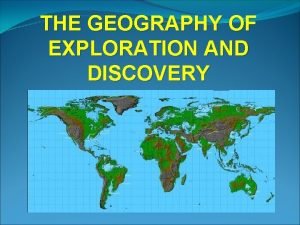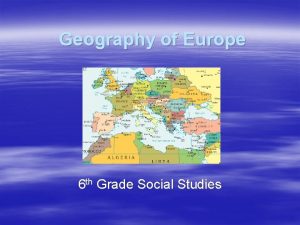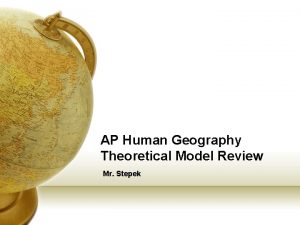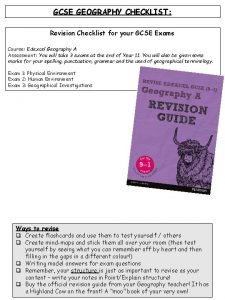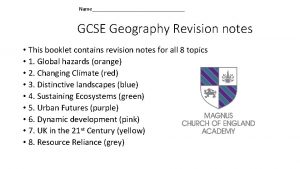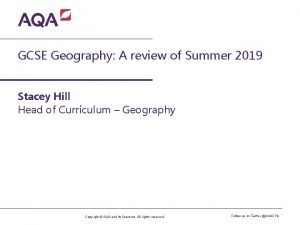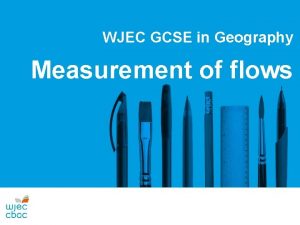WJEC GCSE in Geography Cycles and flows What













- Slides: 13

WJEC GCSE in Geography Cycles and flows

What is the concept? Cycles and flows are two related concepts that help us make sense of geographical processes in both human and physical contexts. These concepts help us to identify patterns of movement: • flows of things in the physical environment such as water • flows of things in the human environment such as commuters

Closed systems Flows exist between stores. In the water cycle, water is stored in the atmosphere, or in surface stores, vegetation, soil and groundwater. Water flows, or is transferred, between these stores by evaporation, precipitation, drip flow, surface runoff and throughflow. This overall pattern can be regarded as a closed system or cycle.

Ecosystems are closed systems Sand dunes are an example of a closed system. Students could investigate: • how inputs to the system (flows of nutrients, water, sunlight) influence vegetation zones within the ecosystem (zonation) • How leisure uses (trampling) can affect these zones

Urban environments are open systems Urban or retail environments could be considered to be open systems – with flows of goods, money, ideas, commuters, migrants, traffic and shoppers flowing in and out of them.

What can I investigate? There are, perhaps, four different ways to approach this fieldwork enquiry. You could design an enquiry to investigate: 1. The relationships between stores and flows 2. How flows change over time 3. How human activities damage or modify cycles or flows 4. How people manage systems to control flows

1. Investigate the relationships between stores and flows How and why the stores and flows within a system are related to one another. Or, how changes to one input can affect other flows within the system. For example: • In a river system, how discharge is related to precipitation. • In two contrasting river systems, how geology or soils affect infiltration or discharge.

2. Investigate how flows change over time How flows change over time. For example, • In a retail environment, how pedestrian flows change throughout the day or during the week and how this impacts on the retail environment. • In a river environment, how infiltration rates and discharge respond to changes in rainfall.

3. Investigate how human activities modify cycles or flows How human activities can change or modify the wider system and impact on cycles or flows. For example, • In a retail environment, how changes to traffic, such as pedestrianisation schemes or creation of one way systems, have affected retail patterns. • In a sand dune ecosystem, how the flow of people (trampling) has affected the cycle of succession. • In a rural honeypot, how trampling has affected infiltration rates.

4. Investigate how people manage systems How people manage systems to try to control flows. For example: • In a river system, how flooding (flows of flood water) can be controlled • In a coastal system, how groynes or artificial reefs can alter flows of longshore drift. • In an urban system, how traffic flows can be managed to make flows safer. For example, deciding on a new cycle path.

So I can do coastal fieldwork? YES! Sediment moves between stores (such as beaches and offshore bars) in a closed system. At A level we would refer to this as a sediment cell. At GCSE it would be appropriate to investigate patterns of longshore drift and / or the ways in which people modify these flows when they manage the coastline – for example, what is the impact of groynes on beach profiles or sediment size and shape?

Or in a retail environment? YES! Students could investigate the relationship between pedestrian flows and economic activity – attempting to define core and periphery within a CBD.

Can I collect human and physical data in the same environment? YES! Urban parks, sand dunes and rural honeypot sites could all be used to investigate the way that natural cycles and flows may be changed through leisure activities. Transects could be used to investigate the extent of trampling at increasing distance from a car park or visitors’ centre: • Physical data – width of footpath, vegetation type and height • Human data – flows of walkers, questionnaires / extended interviews
 Iamis structures
Iamis structures Eduqas electronics gcse
Eduqas electronics gcse Eduqas english language component 2 past papers
Eduqas english language component 2 past papers Wjec gcse ict
Wjec gcse ict Wjec english literature specification
Wjec english literature specification Media studies gcse past papers
Media studies gcse past papers Kondratieff cycles geography
Kondratieff cycles geography Flows definition ap human geography unit 1
Flows definition ap human geography unit 1 Stepek ap human geo
Stepek ap human geo Compare and contrast carbon and nitrogen cycles
Compare and contrast carbon and nitrogen cycles Gcse geography case studies
Gcse geography case studies Aqa gcse geography revision checklist
Aqa gcse geography revision checklist Geography gcse revision notes
Geography gcse revision notes Kendal industrial park aqa
Kendal industrial park aqa






